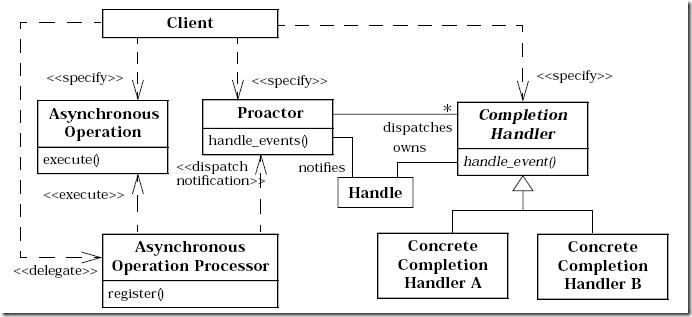6.6.2008
Kevin Lynx
Proactor和Reactor都是并发编程中的设计模式。在我看来,他们都是用于派发/分离IO操作事件的。这里所谓的
IO事件也就是诸如read/write的IO操作。"派发/分离"就是将单独的IO事件通知到上层模块。两个模式不同的地方
在于,Proactor用于异步IO,而Reactor用于同步IO。
摘抄一些关键的东西:
"
Two patterns that involve event demultiplexors are called Reactor and Proactor [1]. The Reactor patterns
involve synchronous I/O, whereas the Proactor pattern involves asynchronous I/O.
"
关于两个模式的大致模型,从以下文字基本可以明白:
"
An example will help you understand the difference between Reactor and Proactor. We will focus on the read
operation here, as the write implementation is similar. Here's a read in Reactor:
* An event handler declares interest in I/O events that indicate readiness for read on a particular socket ;
* The event demultiplexor waits for events ;
* An event comes in and wakes-up the demultiplexor, and the demultiplexor calls the appropriate handler;
* The event handler performs the actual read operation, handles the data read, declares renewed interest in
I/O events, and returns control to the dispatcher .
By comparison, here is a read operation in Proactor (true async):
* A handler initiates an asynchronous read operation (note: the OS must support asynchronous I/O). In this
case, the handler does not care about I/O readiness events, but is instead registers interest in receiving
completion events;
* The event demultiplexor waits until the operation is completed ;
* While the event demultiplexor waits, the OS executes the read operation in a parallel kernel thread, puts
data into a user-defined buffer, and notifies the event demultiplexor that the read is complete ;
* The event demultiplexor calls the appropriate handler;
* The event handler handles the data from user defined buffer, starts a new asynchronous operation, and returns
control to the event demultiplexor.
"
可以看出,两个模式的相同点,都是对某个IO事件的事件通知(即告诉某个模块,这个IO操作可以进行或已经完成)。在结构
上,两者也有相同点:demultiplexor负责提交IO操作(异步)、查询设备是否可操作(同步),然后当条件满足时,就回调handler。
不同点在于,异步情况下(Proactor),当回调handler时,表示IO操作已经完成;同步情况下(Reactor),回调handler时,表示
IO设备可以进行某个操作(can read or can write),handler这个时候开始提交操作。
用select模型写个简单的reactor,大致为:

 /**////
/**//// class handler
class handler


 {
{
 public:
public:
 virtual void onRead() = 0;
virtual void onRead() = 0;
 virtual void onWrite() = 0;
virtual void onWrite() = 0;
 virtual void onAccept() = 0;
virtual void onAccept() = 0;
 };
};

 class dispatch
class dispatch


 {
{
 public:
public:
 void poll()
void poll()


 {
{
 // add fd in the set.
// add fd in the set.
 //
//
 // poll every fd
// poll every fd
 int c = select( 0, &read_fd, &write_fd, 0, 0 );
int c = select( 0, &read_fd, &write_fd, 0, 0 );
 if( c > 0 )
if( c > 0 )


 {
{
 for each fd in the read_fd_set
for each fd in the read_fd_set


 { if fd can read
{ if fd can read
 _handler->onRead();
_handler->onRead();
 if fd can accept
if fd can accept
 _handler->onAccept();
_handler->onAccept();
 }
}

 for each fd in the write_fd_set
for each fd in the write_fd_set


 {
{
 if fd can write
if fd can write
 _handler->onWrite();
_handler->onWrite();
 }
}
 }
}
 }
}

 void setHandler( handler *_h )
void setHandler( handler *_h )


 {
{
 _handler = _h;
_handler = _h;
 }
}

 private:
private:
 handler *_handler;
handler *_handler;
 };
};


 /**//// application
/**//// application class MyHandler : public handler
class MyHandler : public handler


 {
{
 public:
public:
 void onRead()
void onRead()


 {
{
 }
}

 void onWrite()
void onWrite()


 {
{
 }
}

 void onAccept()
void onAccept()


 {
{
 }
}
 };
};


在网上找了份Proactor模式比较正式的文档,其给出了一个总体的UML类图,比较全面:

根据这份图我随便写了个例子代码:
 class AsyIOProcessor
class AsyIOProcessor


 {
{
 public:
public:
 void do_read()
void do_read()


 {
{
 //
// send read operation to OS
send read operation to OS
 // read io finished.and dispatch notification
// read io finished.and dispatch notification
 _proactor->dispatch_read();
_proactor->dispatch_read();
 }
}

 private:
private:
 Proactor *_proactor;
Proactor *_proactor;
 };
};

 class Proactor
class Proactor


 {
{
 public:
public:
 void dispatch_read()
void dispatch_read()


 {
{
 _handlerMgr->onRead();
_handlerMgr->onRead();
 }
}

 private:
private:
 HandlerManager *_handlerMgr;
HandlerManager *_handlerMgr;
 };
};

 class HandlerManager
class HandlerManager


 {
{
 public:
public:
 typedef std::list<Handler*> HandlerList;
typedef std::list<Handler*> HandlerList;

 public:
public:
 void onRead()
void onRead()


 {
{
 // notify all the handlers.
// notify all the handlers.
 std::for_each( _handlers.begin(), _handlers.end(), onRead );
std::for_each( _handlers.begin(), _handlers.end(), onRead );
 }
}

 private:
private:
 HandlerList *_handlers;
HandlerList *_handlers;
 };
};

 class Handler
class Handler


 {
{
 public:
public:
 virtual void onRead() = 0;
virtual void onRead() = 0;
 };
};

 // application level handler.
// application level handler.
 class MyHandler : public Handler
class MyHandler : public Handler


 {
{
 public:
public:
 void onRead()
void onRead()


 {
{
 //
//
 }
}
 };
};


Reactor通过某种变形,可以将其改装为Proactor,在某些不支持异步IO的系统上,也可以隐藏底层的实现,利于编写跨平台
代码。我们只需要在dispatch(也就是demultiplexor)中封装同步IO操作的代码,在上层,用户提交自己的缓冲区到这一层,
这一层检查到设备可操作时,不像原来立即回调handler,而是开始IO操作,然后将操作结果放到用户缓冲区(读),然后再
回调handler。这样,对于上层handler而言,就像是proactor一样。详细技法参见这篇文章。
其实就设计模式而言,我个人觉得某个模式其实是没有完全固定的结构的。不能说某个模式里就肯定会有某个类,类之间的
关系就肯定是这样。在实际写程序过程中也很少去特别地实现某个模式,只能说模式会给你更多更好的架构方案。
最近在看spserver的代码,看到别人提各种并发系统中的模式,有点眼红,于是才来扫扫盲。知道什么是leader follower模式,
reactor, proactor,multiplexing,对于心中的那个网络库也越来越清晰。
最近还干了些离谱的事,写了传说中的字节流编码,用模板的方式实现,不但保持了扩展性,还少写很多代码;处于效率考虑,
写了个static array容器(其实就是template <typename _Tp, std::size_t size> class static_array { _Tp _con[size]),
加了iterator,遵循STL标准,可以结合进STL的各个generic algorithm用,自我感觉不错。基础模块搭建完毕,解析了公司
服务器网络模块的消息,我是不是真的打算用自己的网络模块重写我的验证服务器?在另一个给公司写的工具里,因为实在厌恶
越来越多的重复代码,索性写了几个宏,还真的做到了代码的自动生成:D。
对优雅代码的追求真的成了种癖好. = =|